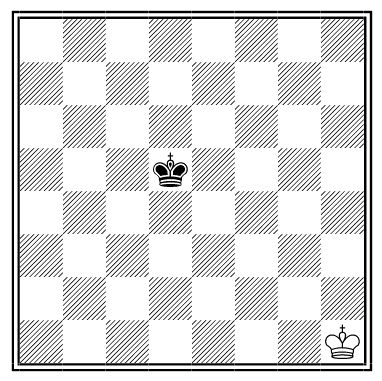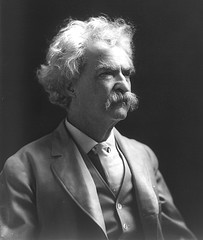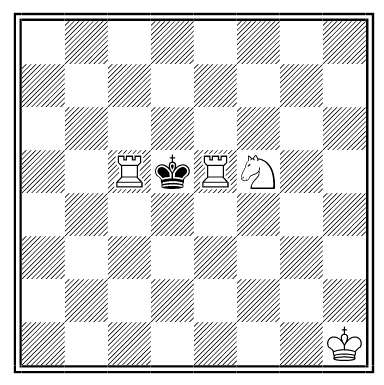28 + 48 + 68 + 78 + 88 + 08 + 58 + 08 = 24678050
A Scottish Enigma
In the course of some structural alterations to an ancient house near Edinburgh three unknown rooms were brought to light, bearing testimony of their last inmate. One of them had been occupied as a bedroom. The clothing of the bed was disarranged, as if it had been slept in only a few hours previously, and close by was an antique dressing-gown. How interesting it would be to know some particulars of the sudden surprise which evidently drove the owner of the garment from his snug quarters — whether he effected his escape, or whether he was captured! The walls of this buried chamber, if they could speak, had some curious story to relate.
— Allan Fea, Secret Chambers and Hiding-Places, 1908
Tableau
Place two white rooks and a white knight on this board so that Black is checkmated:

The solution need not be reachable in a normal game.
Unquote
“Wit is educated insolence.” — Aristotle
Scandal
In 1394, a pig was hanged at Mortaign for having sacrilegiously eaten a consecrated wafer; and in a case of infanticide, it is expressly stated in the plaintiff’s declaration that the pig killed the child and ate of its flesh, “although it was Friday,” and this violation of the jejunium sextae, prescribed by the Church, was urged by the prosecuting attorney and accepted by the court as a serious aggravation of the porker’s offence.
— E.P. Evans, The Criminal Prosecution and Capital Punishment of Animals, 1906
Wherever

At the height of Mark Twain’s popularity, a group of his friends in New York wanted to send him a birthday greeting.
But Twain was traveling abroad and none of them knew where to direct the letter.
After some hopeless havering they simply addressed it “Mark Twain, God Knows Where.”
Several weeks later a note arrived from Twain.
It said: “He did.”
Presto
Pick a three-digit number (example: 412).
Double it to create a six-digit number (412412).
Divide the result successively by 7, by 11, and by 13. There will be no remainders.
The result is the original number.
In Memoriam
Epitaph of John Laird McCaffrey (1940-1995), who lies in Montreal’s Mount Royal Cemetery:
John:
Free your body and soul
Unfold your powerful wings
Climb up the highest mountains
Kick your feet up in the air
You may now live forever
Or return to this earth
Unless you feel good where you are!
It was composed jointly by his ex-wife and mistress.
Read the first letter of each line.
Where’s the Fallacy?

Trivium
Twelve percent of people dream only in black and white.

